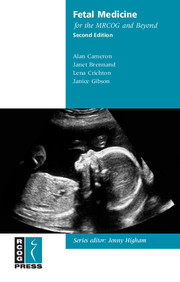Book contents
- Frontmatter
- Contents
- Preface
- Abbreviations
- 1 Screening for chromosomal abnormalities
- 2 Prenatal diagnostic techniques
- 3 The routine anomaly scan
- 4 Fetal structural abnormalities
- 5 Fetal therapy
- 6 Prenatal diagnosis and management of non-immune hydrops fetalis
- 7 Termination of pregnancy for fetal abnormality
- 8 Fetal growth restriction
- 9 Twin pregnancy
- 10 Fetal infection
- Index
9 - Twin pregnancy
Published online by Cambridge University Press: 05 August 2014
- Frontmatter
- Contents
- Preface
- Abbreviations
- 1 Screening for chromosomal abnormalities
- 2 Prenatal diagnostic techniques
- 3 The routine anomaly scan
- 4 Fetal structural abnormalities
- 5 Fetal therapy
- 6 Prenatal diagnosis and management of non-immune hydrops fetalis
- 7 Termination of pregnancy for fetal abnormality
- 8 Fetal growth restriction
- 9 Twin pregnancy
- 10 Fetal infection
- Index
Summary
Introduction
Twin pregnancies are associated with significantly increased rates of fetal loss, neonatal loss and neonatal morbidity than singleton pregnancies. Perinatal mortality data collated for the United Kingdom demonstrate a stillbirth rate approximately 2.5–3.0 times that seen in singleton pregnancies and a neonatal loss rate of approximately seven times that seen in singleton pregnancies. The adverse outcome of twin pregnancy reflects an increased risk of virtually all obstetric complications, particularly preterm delivery and fetal growth restriction, in addition to specific complications of monochorionic twins.
Classification of twin pregnancy
Twins can be classified by their zygosity (number of fertilised ova – nonidentical dizygotic twins or identical monozygotic twins) or by their chorionicity (the number of placentae – dichorionic or monochorionic/one shared placenta). The latter classification is of clinical relevance for three important reasons: (1) it can be determined antenatally, (2) it influences prenatal screening and the management of certain obstetric complications and (3) it predicts the risk of specific complications. Monochorionic twins have a six-fold risk of loss before 24 weeks of gestation and two to three-fold increased risk of stillbirth and early neonatal deaths when compared with dichorionic twins.
EMBRYOLOGY OF MONOCHORIONIC TWIN PREGNANCY
Approximately 30% of twins are identical or monozygotic, of which 70% are monochorionic (Figure 9.1). This occurs when a single fertilised ovum splits into identical twins 3 days after fertilisation. At this point in time, the outer chorion has started to differentiate and so, although embryo division occurs, the resultant fetuses will share an outer chorion (placenta and chorionic membrane).
- Type
- Chapter
- Information
- Fetal Medicine for the MRCOG and Beyond , pp. 153 - 172Publisher: Cambridge University PressPrint publication year: 2011

